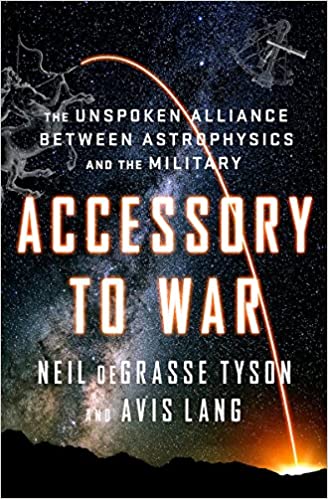Space has gained prominence in recent years as an independent warfighting domain. This has resulted in renewed calls for nations to commit to space law reforms aimed at limiting the militarisation of space. The truth is though, space has been militarised (but not weaponised) for decades and has been of military interest for centuries. Accessory to War explores the historical links between astronomy, astrophysics, military operations, geostrategic competition and international law. A key focus is highlighting the difference between the militarisation and weaponisation of space.
The book strikes an acutely anti-war tone throughout, however this is balanced by a pragmatic acknowledgement of the political realities that have driven public funding of scientific research throughout the past 250 years. The authors argue that astrophysicists (and engineers) tend to produce dual use technologies that attract a lot of the public investment in space technologies. They describe a relationship between scientists and the military which is mutually beneficial but ethically incompatible.
The anti-war feel of the text doesn’t detract from its utility to military readers as it provides expert insights into the topic from an outsider’s perspective.
The book is laid out chronologically and begins with the early days of celestial navigation. Those with the greatest knowledge of the stars had a navigational advantage which could be exploited for military purposes. It then moves to the origins of the telescope and outlines how it was adapted for military use as the spyglass. This in turn led to a surge of innovation in glass manufacturing during the 19th century as the country with the best lenses could produce the best telescopes. The main tactical advantage of this was detecting an adversary from greater ranges, improving early warning times. Another benefit was the ability to transmit visual messages over longer distances which improved tactical communications.
The ongoing development of navigation, time keeping, telecommunication and radar technologies are all touched upon; starting with the fundamental scientific discoveries that made them possible and how they relate to astrophysics. The authors then explain how these technologies were militarised, bringing the reader up to the end of the second world war and the dawn of the nuclear and space ages.
Here the book re-focuses on how the pressures of the Cold War saw Western and Warsaw Pact governments alike turn to space seeking an advantage in the escalating arms race. In space they saw the ultimate high ground from which to observe the enemy; the final frontier of human exploration on which to champion their national prestige; and an ability to establish persistent, survivable and prompt global strike capabilities. Scientists and engineers were needed to turn the vision into reality and those same scientists and engineers required funding for their research areas if they were to make it happen. Government funding flowed to the sciences and the space race was born.
The later chapters do a good job of explaining the geopolitical tensions of the Cold War and the Space Race alongside the domestic political tensions that went into funding these large-scale science and military projects. This includes a good explanation of the origins of the various space treaties that have been in force at various times since the 1960s. Part of this is understanding who was advocating for what treaty, at what time, and for what reason. Often it was to cover for a perceived domestic weakness, usually economic constraints. There was also a strong overlap between the treaties governing the use of space and arms control efforts aimed at managing Cold War tensions. This is a natural relationship since some of the rockets used to reach orbit, particularly in the early 1960s, were simply repurposed intercontinental ballistic missiles.
This inevitably leads to a discussion of the Raegan administration’s so-called 1980s “Star Wars” plans and whether those policies had any role in exacerbating the economic problems of the Soviet Union immediately prior to its dissolution.
The book ends by exploring the current state of various nation’s space agencies, including their current funding and how that has changed over the past 20 years. This gives a picture of the current relative strengths and weaknesses of the key players as well as a sense of where the momentum lies.
Overall Accessory to War is a good primer for anyone interested in better understanding space as a warfighting domain. The historical perspective is illuminating and enjoyable as it also covers other important topics such as radar development, arms control, and geopolitics. While the topics are diverse and cover highly technical fields, the language is simple and clear. This makes the content accessible to readers without a scientific or engineering background.
About the author: Chris is an Associate Editor at Grounded Curiosity and a currently serving Australian Army officer. Building on a multi-discipline engineering background, his passion is technological development and PME. Chris’ work has previously appeared on Grounded Curiosity, Strategy Bridge and The Cove. Find him on Twitter.

